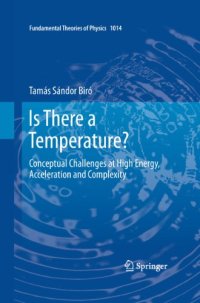
Ebook: Is There a Temperature?: Conceptual Challenges at High Energy, Acceleration and Complexity
Author: Tamás Sándor Biró (auth.)
- Genre: Mathematics // Applied Mathematicsematics
- Tags: Thermodynamics, Physical Chemistry, Elementary Particles Quantum Field Theory, Classical Continuum Physics, Mathematical Methods in Physics
- Series: Fundamental Theories of Physics 171
- Year: 2011
- Publisher: Springer-Verlag New York
- Edition: 1
- Language: English
- pdf
Physical bodies can be hot or cold, moving or standing,simple or complex. In all such cases one assumes that their respective temperature is a well defined attribute. What if, however, the ordinary measurement of temperature by direct body contact is not possible? One conjectures its value, and yes, its very existence, by reasoning based on basic principles of thermodynamics.
Is There a Temperature? Conceptual Challenges at High Energy, Acceleration and Complexity, by Dr. Tamás Sándor Bíró, begins by asking the questions “Do we understand and can we explain in a unified framework the temperature of distant radiation sources, including event horizons, and that of the quark matter produced in high energy accelerator experiments? Or the astounding fluctuations on financial markets?”
The book reviews the concept of temperature from its beginnings through the evolution of classical thermodynamics and atomic statistical physics through contemporary models of high energy particle matter. Based on the views of high energy nuclear physicists, it crosses over several traditional disciplines of university physics. Recent developments towards an abstract, general and thermodynamically consistent treatment of non-extensive systems are worked in. Exercise problems and solutions help to deepen the reader’s understanding into the details behind the theories.
Temperature and heat, entropy and order or disorder are key classical concepts of physics. These are challenged by searching matter under extreme conditions, such as high (relativistic) energy, strong acceleration or gravitation, or unusual complexity due to long range correlations. In our quest for quark matter all these conditions might occur simultaneously. This book, strongly motivated by the authors' everyday research experiences in the field of high-energy heavy-ion collisions, aims to bundle these challenges to modern physics.The main topic is at the heart of thermodynamics -- the very concept of temperature, its use and extensions. New developments on this issue are both applications and foundations of non-extensive statistics, as well as concepts borrowed from gravity and string theory to describe the surprisingly statistical behavior of elementary matter at the highest accelerator energies of the world.The reader will benefit from bringing these new developments in one book together, by having the view of classical and modern concepts at the heart of physics across the problems related to high-energy, high acceleration and high complexity. After reviewing the classical approaches, the author discusses the dual-gravity and non-extensive statistical aspects of heavy-ion collisions, describing these experimental findings with the use of the concept of temperature.